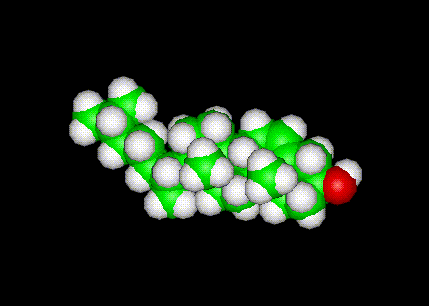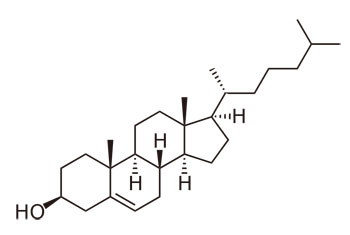Cholesterol Molecule

For 3-D Structure of Nicotine Molecular Structure using Jsmol
Cholesterol is a steroid lipid, found in the body tissues (and blood plasma) of vertebrates. It can be found in large concentrations within the liver, spinal cord, and brain. It plays a central role in many biochemical processes, but is best known for causing cardiovascular disease when present in elevated levels.
Physiology
Synthesis
The HMG-CoA reductase pathwayCholesterol is primarily synthesized from acetyl CoA through the HMG-CoA reductase pathway in the liver (~1 g/day), although other sites include the intestines, adrenal glands and reproductive organs.

Properties
Mostly insoluble in water, it travels in the blood stream in the form of lipoproteins. Initially, it is carried from the intestinal mucosa to the liver in chylomicrons. In the liver it is converted into low-density lipoprotein (LDL) to carries cholesterol to the body cells, while high-density lipoprotein (HDL) carries it back to the liver for excretion.
It is interesting to note that the cholesterol in LDL cholesterol and the cholesterol in HDL cholesterol are identical. The only difference between the two is the carrier molecule (i.e. the lipoprote.)
Regulation
The production is directly regulated by the present cholesterol levels, and a higher intake in food leads to a net decrease in endogenous production. The main regulatory mechanism is the sensing of intracellular cholesterol in the endoplasmic reticulum by the protein SREBP (Sterol Regulatory Element Binding Protein 1 and 2). In the presence of cholesterol, SREBP is bound to two other proteins: SCAP (SREBP-cleavage activating protein) and Insig-1. When cholesterol levels fall, Insig-1 dissociates from the SREBP-SCAP complex, allowing the complex to migrate to the Golgi apparatus, where SREBP is cleaved by S1P and S2P (site 1/2 protease), two enzymes that are activated by SCAP when cholesterol levels are low. The cleaved SREBP then migrates to the nucleus and acts as a transcription factor to bind to the "Sterol Regulatory Element" of a number of genes to stimulate their transcription. Amongst the genes transcribed are the LDL receptor and HMG-CoA reductase. The former scavenges circulating LDL from the bloodstream, while HMG-CoA reductase leads to an increase of endogenous production of cholesterol.
A large part of this mechanism was clarified by Dr Michael S. Brown and Dr Joseph L. Goldstein, who received the Nobel Prize in Physiology or Medicine for their work in 1985.
A study by Ockrene et al showed that there are seasonal variations in cholesterol levels in humans. Although no explanation could be found, it explains why more patients may be diagnosed with elevated cholesterol levels in winter
Function
Cholesterol is an important component of the membranes of cells, providing stability. It is the major precursor for the synthesis of vitamin D, of the various steroid hormones, including cortisol, cortisone, and aldosterone in the adrenal glands, and of the sex hormones progesterone, estrogen, and testosterone. Further recent research show that cholesterol has an important role for the brain synapses as well as in the immune system.
Excretion
Cholesterol is excreted from the liver in bile; under certain circumstances it can crystallise in the gallbladder to become a major constituent of gallstones, although lecitin and bilirubin gallstones can also occur.